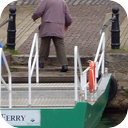(short preview of full seamless looping track)
Saale River Cable Ferry
This product is not available in the selected currency.
In Stock
Backordered
Out of Stock
Description
The cold water washes against the side of the ferry as you sit in the stilted sunlight, hidden behind a broad stretch of grey clouds that seem to keep coming, never kneeling before the beauty of summer's true face. The cable rattles against the bow and everyone watches the former shore recede and the new one come into view. It's strange to be on a boat without a captain, but your friends assure you that this method is actually much safer. A cable ferry is guided and in many cases propelled across a river or other larger body of water by cables connected to both shores. They are also called chain ferries, floating bridges, or punts. Early cable ferries often used either rope or steel chains, with the latter resulting in the alternate name of chain ferry. Both of these were largely replaced by stronger and more durable wire cable by the late 19th century. Cable ferries have probably been used to cross rivers and similar bodies of water since before recorded history. Examples of ferry routes using this technology date back to the 13th century. They were particularly prominent in early transportation in the Sacramento Delta of California. At one time, cable ferries were a primary means of automobile transportation in New South Wales in Australia. In Tasmania, for a century before 1934, the Risdon Punt at Hobart was the only fixed method of crossing the Derwent River within Hobart city limits. Ferries are common where there is little other water-borne traffic that could get snagged in the cable or chains, where the water may be too shallow for other options, or where the river current is too strong to permit the safe crossing of a ferry not attached to the shore. Alignment of the platform at each end of the journey is automatic and, especially for vehicle ferries, safer than a free-moving ferry might be in bad conditions.
Opps
Sorry, it looks like some products are not available in selected quantity.



